Fundamentals of Hardened Concrete
Monolithic concrete with a compressive strength in excess of 3500 pounds per square inch (psi) is watertight, except at any irregularities in the structural element. Typical locations where irregularities occur include overhead decks, floors, and walls that have cracks, honeycombs, joints, mechanical/electrical penetrations, and form-tie supports. Hairline cracks in excess of 1/1000 of an inch (i.e. 1 mil) commonly leak water if subject to hydrostatic pressure. Water leakage rate and volume, or quantity, is related to pressure and crack width.
Concrete Cracking
When concrete is freshly cast, its temperature is often between 60º and 90º F. Depending on the in-situ form, materials, temperature, environmental conditions, and composition of the mix design, concrete hydration may generate significant additional heat. Thermal expansion of the semi-plastic structural element will occur and, depending upon local restraint, may cause micro-cracking.
Depending on local restraints, minute small cracks (defects within the cement/aggregate matrix typically so small they can’t be seen by the naked eye) develop externally and internally. After the forms are removed, the concrete continues to shrink from both cooling and loss of water. This process varies with environmental conditions and may create cracks capable of water leakage within hours of form removal, and within days after wet curing. For most structural elements less than 14 inches thick, it takes about 5 years for shrinkage to subside. In this time, the cracks initiated by thermal contraction become much larger. These cracks, depending on reinforcing, sectional dimensions, mix design, and restraint conditions, can be as large as 5 to 50 mils. If subjected to water under hydrostatic pressure, serious leakage will occur.
Ingredients for Corrosion
Corrosion in reinforced concrete requires three basic ingredients; oxygen, water, and an electrolyte medium. Fundamental to corrosion mitigation is minimizing at least one of these three basic ingredients.
Issues from Leakage
One of the biggest concerns with water leakage in heavily reinforced concrete is that the time for the onset of corrosion is shortened. It is well understood that if you eliminate oxygen and water from the immediate environment around reinforcing steel, corrosion is generally minimal and essentially mitigated. When through-element cracks occur from outside to inside face, allowing air or dissolved oxygen in the water to interact with the steel, all three of the critical items are now available for corrosion to occur.
In addition to corrosion, water leakage can bring salt and various stray minerals that can exacerbate other issues within the concrete, e.g., sulfate attacks. External issues with water leakage are many – ice buildup, slip problems, treatment of contaminated water, and potential mold issues.
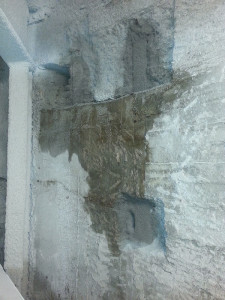
Monolithic concrete with a compressive strength in excess of 3500 PSI is watertight, except at any irregularities.
Fundamentals of Interception Grouting
Directional Drilling
The objective of interception grouting is to make the concrete element monolithic. This can be achieved by pressure injecting a resinous material through one or both concrete element faces (surface mounted ports), or by drilling at a 45-degree offset to the defect and injecting into the defect in the center third of the concrete element section (interception grouting). The importance of drilling into the center of the concrete element is that, during grouting, the resinous material should flow equally to the inside and outside face of the concrete section in a uniform manner. If drilling into the interior third of the section, grout flow will not extend to the exterior. Drilling into the outer third of the section will unlikely allow grout migration to the interior. By proper placement of drill holes, grout flow will intersect from bottom-to-top or side-to-side with a relatively high degree of reliability. Long-term grouting solutions intercept the defect in the center; short-term solutions allow shallow drill depth holes. In addition to crack interception at the concrete element’s center third, most quality contractors alternate directional drilling on each side.
Drill Hole Spacing
Generally, the rule of thumb is that drill hole spacing should be one half to two-thirds the concrete element thickness. This allows an overlap of about 20 to 30 percent between drill holes. Drill hole spacing up to the width of wall element can be done if cracks are relatively large – i.e. 50 to 100 mils wide.
Interior and/or exterior steel can influence the drilling angle based on its density and location. Angles of 30º to 60º are not uncommon provided that interception drilling is done in the wall center. Because cracks vary in direction, drilling should be 20 to 25 percent deeper for interception grouting than what the typical calculations dictate. Drill hole diameter is not critical and can be left to contractor preference.
Cleaning
Just as important as intercepting the crack at the element midsection is cleaning the drill hole of debris prior to setting any ports. Injection drill holes should be blown out with high pressure air and then flushed thoroughly with a water jet. Some contractors even push and flush a wire bristle brush down the drill hole and scrub the area of intersection to remove surface debris.
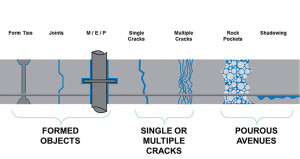
Typical water leakage paths.
Crack Flushing
The next important aspect is to put a port on the surface and flush the crack. Flushing the crack is important for two reasons:
1) To push out any mineral deposits (clay, silt) that may have accumulated in the crack, and
2) If water is pumped and does not make it to the surface of the concrete, grout will not make it through either.
These are often questions as to whether or not some kind of acidic material (e.g., phosphoric or muriatic) should be used. Generally, it is an acceptable approach, but it should come with some safety precautions and the use of proper personal protective equipment to keep acid away from the face.
Acid washing the drill hole and the crack improves the bond ability of any type of resin that is injected into the crack later. If the crack has debris and mineral deposits, the effectiveness of the grout will not be as monolithic as needed, and secondary or minor leakage could still occur.
Pressure
Interception grouting should be done in a way that the internal hydraulic pressures of the grout never exceed the tensile strength of the concrete. The tensile strength of concrete is 10% of the compressive strength. Most concrete that interception grouting will be performed on will have a tensile strength of 300 to 500 psi. It is recommended not to use pumping grout pressures in excess of 500 psi. In so doing, the concrete surface may spall where the drill holes exist and/or the pressure may hydraulically fracture the concrete and create additional cracks.
A word of caution, use of high viscosity resins may lead to internal damage of the concrete. High viscosity resinous materials are not as user friendly as low viscosity injection materials. For comparison, water has a viscosity of one centipoise – so grouts that have values of 50 to 300 centipoises means that they are 50 to 300 times more viscous than water.
It is not uncommon for contractors who do not have a good understanding of viscosity and crack width to use resinous grouts with 300 upwards to 500 centipoises and pressures up to 3000 psi to accomplish placing resinous material within the crack.
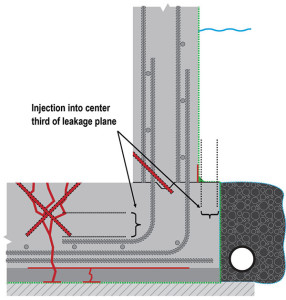
It is important to intercept the crack at the center third so that the resinous material flows equally to the inside and outside face of the concrete section.
Grout Delivery
There are three types of delivery systems generally utilized: small hand operated pumps, small electric operated pumps, and high volume air driven or piston driven pumps. Most hand and small electric driven pumps are for single component resins. The larger piston pumps can be used for 1-3 components.
Small electric pumps require minimal maintenance. However, after several uses the pumps are discarded and new ones are purchased. Others prefer to buy the large piston drive, both single and multi-ratio. What’s important is that these pumps have a capacity of ¼ gallon per minute and have pressure capabilities up to 750 psi.
Injection Packers
There are basically three types of injection packers – button head, grease zerk, and ball valve quick connect. The advantage of the grease zerk packers is that they are inexpensive and can be discarded after one use. Button head packers are similar and usually discarded after one use. The ball valve quick connect packers are more expensive, but can be reused multiple times. Another advantage of the ball valve is that you can open and close the valve to monitor water or grout flow. Button head and ball valve quick connect packers generally do not restrict grout flow and increase pump gauge pressure during application. Disadvantages of zerk packers are that they cannot be opened and closed to monitor grout movement and they are very restrictive to grout flow, requiring about 100 to 200 psi gauge pressure just to move most grouts through them.
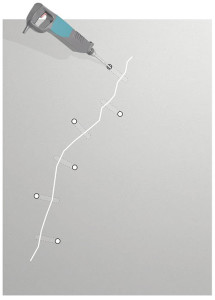
Most quality contractors alternate directional drilling on each side.
Causes of Premature Grout Failure
There are 4 basic causes of premature grout failure:
1) Improper drilling and delivery
It is not uncommon for contractors to drill directly into the crack or too close to the surface. By doing this, a seal is created that is 1/3 to ½ of the crack depth and water under hydrostatic pressure is still within the concrete element. Very little flexural movement causes leakage to recur.
2) Inadequate mixing ratio of water to grout during application
Most contractors are taught by manufacturers that pre-wetting the crack prior to urethane grout injection is all that is needed to activate the material. This would likely be the case of the wall 4 to 6-inches or less in thickness. Wall and floor sections greater than 12 inches would not fit the criteria however, and a multi-ratio pump for injecting water reactive urethane grouts should be used.
Some contractors prefer to use two small electric pumps – one to inject urethane, one to inject water – and then rotate a few strokes of water to several strokes of grout thinking they are getting good cross-polymerization of water to urethane. While this may seem a viable solution because the first grout that comes to the surface appears to be fully reacted, it is very common to have areas of water deprived urethane grout within cracks and other defects. When these conditions are subjected to high temperatures in the environment (in excess of 100 to140º Fahrenheit), it is common to see a brown, unreacted urethane resin extrude from the cracks anywhere from 2 months to 2 years after the initial grouting. This urethane resinous material has now contaminated the crack for future injection. Many contractors have found that the only viable way to seal cracks with unreactive grouts is the backside grouting method.
3) Excessive wall movement
Excessive movement is most prevalent when the concrete is subject to outdoor temperatures – i.e. exterior tanks, retaining walls, exposed foundations, etc. Most resins have some degree of flexibility. It is not uncommon that during warm to cold cycles, a 5 mil crack will open to a 10 mil crack. Most resinous grouts, even though they are called flexible, cannot sustain repeated opening and closing of the crack and will fail. Grout adhesion to the substrate may fail during expansion and contraction of the crack if surface contaminants on the grout sidewall are prevalent.
4) Chemical attack
Chemical attack is very common in the industrial environment, and this type of issue usually takes several years to work its way through the grout matrix. Residue hydrocarbons within water will commonly attack many of the grout formulations. This is exacerbated if chemical attack and thermal expansion/contraction are occurring simultaneously.
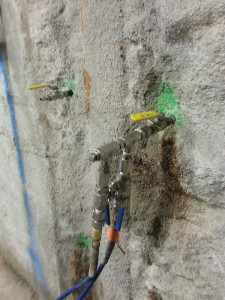
To achieve the right mixing ratio of water to grout, a multi-ratio pump should be used.
Conclusion
It is important for engineers and contractors alike to remember that the grout viscosity needs to match up with the crack width, and the grout chemical resistance needs to match the exposure. The most successful grouting contractors have a good knowledge of chemical resistance and have good field experience in developing techniques that allow them to get low viscosity grouts to migrate deeply within finely cracked concrete.▪
